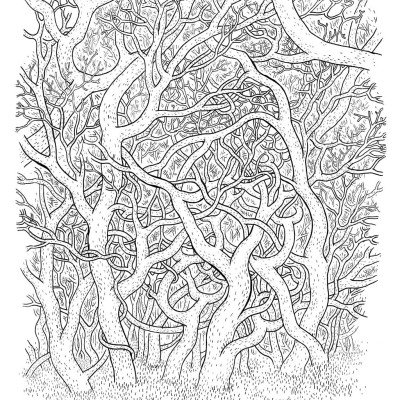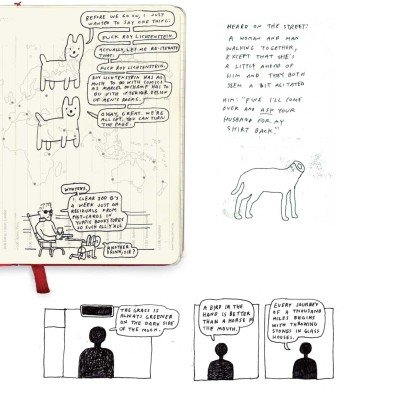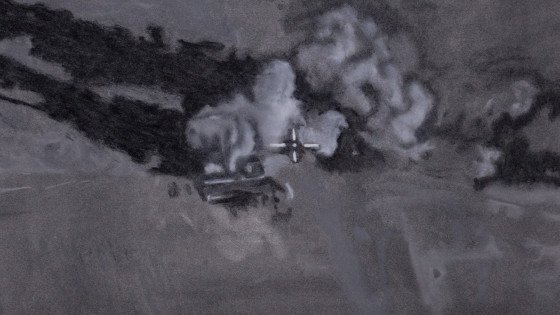Anders Nilsen
Interview
People trying to explain how the universe works used to mean religion.
L&M: Conversation Gardening is an interesting interactive drawing exercise, one with a political agenda. Tell me more about the origin of this project and how it works. What becomes of the finished drawings?
AN: Yeah, the Conversation Gardening project started as a kind of interactive protest against Amazon, which was retaliating against authors and publishers who were critical of it. I wanted to register my protest, but in a positive way where I wasn’t just yelling about someone being a corporate asshole. So I did a little comic strip about why I feel the way I do about how they operate, putting it into a historical context as part of the cultural “conversation” through history that’s been taking place and pushing society forward as long as art and writing have existed. Something that I – and they – are actually a part of and ought to take seriously. So I asked people to buy my work from an independent source, and then send me a question or an idea on a piece of paper, offering to do a drawing in response and send it back to them. It was somewhat more successful than I expected and now, a year later I am still slowly working my way through them. But it’s been a really fun, interesting exercise, playing with people’s ideas. I post them on my blog as I go, and a few people have asked whether I will eventually publish them as a book, which may happen. We’ll see. I’ve also enlisted a few other artists to participate, including Zak SallyZak SallyZak Sally is a bassist and a comic artist. He was formerly the bassist for the bands Low and Enemymine (with Mike Kunka of godheadSilo). He is native of Duluth, Minnesota, currently owns and operates his own press, La Mano, in Minneapolis. La Mano serves as a publisher for Sally"s works as well as those of other comic artists including John Porcellino and William Schaff. Sally also had a cameo in the movie Shopgirl, as a member of the band Hot Tears. Sally is also a comics art professor at the Minneapolis College of Art and Design. (wiki) and Eleanor DavisEleanor DavisEleanor McCutcheon Davis (born January 16, 1983) is an American cartoonist and illustrator who creates comic works and other art for both adolescent and adult audiences. Mostly a self-publisher, Davis has produced many comics on her own, including The Beast Mother. Outside of her self-published comics, Davis"s work has been included in five issues of Fantagraphics" anthology MOME as well as Houghton Mifflin"s Best American Comics in 2008. (wiki).
L&M: In a drawing from Conversation Gardening, regarding GilgameshThe Epic of GilgameshGilgamesh (originally Bilgamesh) is the main character in the Epic of Gilgamesh, an Akkadian poem that is considered the first great work of literature, and in earlier Sumerian poems. In the epic, Gilgamesh is a demigod of superhuman strength who builds the city walls of Uruk to defend his people and travels to meet the sage Utnapishtim, who survived the Great Flood. (wiki), you speak about the act of storytelling, and you seem proud to be a link in a great chain of storytellers from Gilgamesh to your Lutheran minister grandfather, to you. The role of the storytelling in society and the role of the storyteller, is obviously important to you.
AN: Yeah, I probably think of myself that way more than anything else. I mean that’s the important thing. It’s like the drawing is a vehicle for doing that, for me. Storytelling and making meaning are the things that make us human. Maybe that’s a little bit of what this book I’m working on now is gonna be about, making meaning out of the world. Stories are the way we create a structure for the chaos of living a life in the universe. There is no actual structure or pattern to the unfolding of events, but we have brains that demand it, and seek it out, whether it’s there or not. I think going through something like death and extreme loss – which is a sort of meaningless, non-sensical, traumatic event, your brain really really wants to make order out of that, and one of the main ways that it does that is through telling the story of it over and over again.
L&M: You could argue that religion was spawned from that very story about death.
AN: Yeah, right. You could argue that all art in general is in some way about death – it’s the arrangement of structures to create order out of what doesn’t feel like it has any.
L&M: On the topic of religion, you obviously have a huge interest in it as is evident in just about all of your work. In your interviews you talk about it quite a bit and you also talk about your Lutheran Minister grandfather and uncle, and you said you spent some time being around the church. In Poetry is Useless, you are critical of religion, but at the same time you seem to admire it. Sometimes it feels you even have a Buddhist take on things. Also in Rage of Poseidon, you found a unique and humorous outlet for these conflicts about religion.
AN: Yeah, I’m aware that the way I talk about it, there is a conflict there, and that some of my readers feel conflicted about it. But I don’t experience it as a conflict myself. You mentioned Buddhism. For me the reference point is the Tao Te ChingTao Te ChingThe Tao Te Ching, Daodejing, or Dao De Jing, also simply referred to as the Laozi is a Chinese classic text. According to tradition, it was written around 6th century BC by the sage Laozi (or Lao Tzu, literally meaning Old Master), a record-keeper at the Zhou dynasty court, by whose name the text is known in China. The text"s true authorship and date of composition or compilation are still debated, although the oldest excavated text dates back to the late 4th century BC.The text, as well as with the Zhuangzi, is a fundamental text for both philosophical and religious Taoism, and strongly influenced other schools, such as Legalism, Confucianism, and Chinese Buddhism, which when first introduced into China was largely interpreted through the use of Daoist words and concepts. Many Chinese artists, including poets, painters, calligraphers, and even gardeners, have used the Daodejing as a source of inspiration. Its influence has also spread widely outside East Asia, and is among the most translated works in world literature. (wiki). That’s a very important book to me and it’s full of paradoxes. Religious mysticism or even particle physics is full of all sorts of contradictions and paradoxes. Religion is totally absurd and potentially extremely harmful and it also has produced a great deal of beauty and meaning. So I sort of love those contradictions. They’re funny and they’re true and they’re provocative.
One of the reasons that I keep going back to religion is that religion is the quintessential meaning-making that humans have done. Like now we have all these mechanisms for figuring out what’s true and what’s not true. We have investigative journalists and we have historians and particle physicists. Humans didn’t used to have all that stuff and so storytelling was what we used to make sense of things on much more profound level. People trying to explain how the universe works used to mean religion. So it’s compelling to me for that reason and because it’s still bound up as this thing [that] some people think is actually literally true and some people don’t, and that’s crazy. (laughs)
L&M: To that end, as you say, even in the face of investigative journalists, historians and particle physicists, American politics is still wrapped up in religion and strongly influences public policy. Do you feel that through your drawing you’re trying to get a message across regarding this?
AN: I probably wouldn’t say I’m trying to get any message across. If anything I feel a little bad, because I, you know, there are certain, not the people in my immediate family by any means, but there are certain people in my life, who, if they read my books they probably would be a little bummed out about the way that I talk about it. And I like those people. They’re great people. They happen to be fundamentalists, but that doesn’t mean… I have a lot of problems with the political agendas of fundamentalists, but a lot of them are really nice people, and do a really great job raising their kids. So yeah, I don’t know. There’s not really a political agenda behind that work. It’s much more just me looking out at the world and being interested in the weirdness of it and playing around with the strangeness of this phenomenon.
[foogallery id=”6602″]
Anders Nilsen, “Conversation Gardening.” (Ongoing self-published project)
[foogallery id=”6636″]
Anders Nilsen, Biblical story of Noah and the Ark from “Rage of Poseidon.” (Drawn & Quarterly, 2013)

Anders Nilsen, Illustration for the New York Times.
Anders Nilsen, “Adam and Eve Sneaking Back into the Garden to Steal More Apples.” 2012. Ink on Paper. 90″ x 55″
A good joke is very similar to very great poetry where you feel like for a second you have a key to the universe.
L&M: If that’s the case, then where does the reader come into it? Do you hope that they will be affirmed by it somehow, or just amused, entertained, all of the above?
AN: Yeah, all of the above I guess. I mean hopefully they’ll think it’s funny. I guess part of the point of it is to encourage people to find some comfort in those paradoxes, or in those contradictions, to try to point them out, help people get comfortable with them.
L&M: So then is this the role of drawing and art in your life?
AN: I mean part of it is like, if you do a cartoon just right or you tell a joke just right… I mean a good joke is like, and there’s a line in my book too that has something like this, but a good joke is very similar to very great poetry where you feel like for a second you have a key to the universe. You have just understood something in a way that is fundamentally true. So that’s what it is for me, sort of trying to key into how our minds work and how the universe works, and my presumption is if I’m doing that for myself, then maybe I can do that for a reader, like they’ll feel that same sort of rhyming of the universe.
L&M: Is that why you’re drawn to humor in particular? Is humor the best way to tackle these huge subjects?
AN: Not necessarily, you can make people laugh, but if you can make somebody cry that’s just as good. (laughs) I have a good friend who’s a painter and I remember talking about that with him when we were students, talking about it like, just imagine if you could make a painting that would cause a physical reaction in your viewer. I don’t think I thought about this at the time, but later I sort of realized that that’s what laughter is, and that’s what crying is. If you can make someone shed actual tears, you have created an actual experience in the world.
L&M: Maybe it was easier to make someone cry 100 years ago. People used to cry listening to Beethoven, which probably doesn’t happen much anymore.
AN: (laughs) Right. Yeah, If nobody cries because they read my comic that’s fine. (laughs) But I think… I’m trying to think of a good example… People go to sad movies and they cry, or people go to horror movies and have a physical reaction. And I think that is actually part of the distinction between high and low art, or like literature and genre. With high-art you’re supposed to reflect in your highest mind and appreciate it aesthetically and intellectually. Whereas genre is supposed to get your heart pumping a little bit, and make you excited, or if you read a romance novel you cry, or a stand up comedian makes you laugh or whatever. So there is like a sort of a mind-body hierarchy there, which is another one of those paradoxes I am interested in collapsing.







